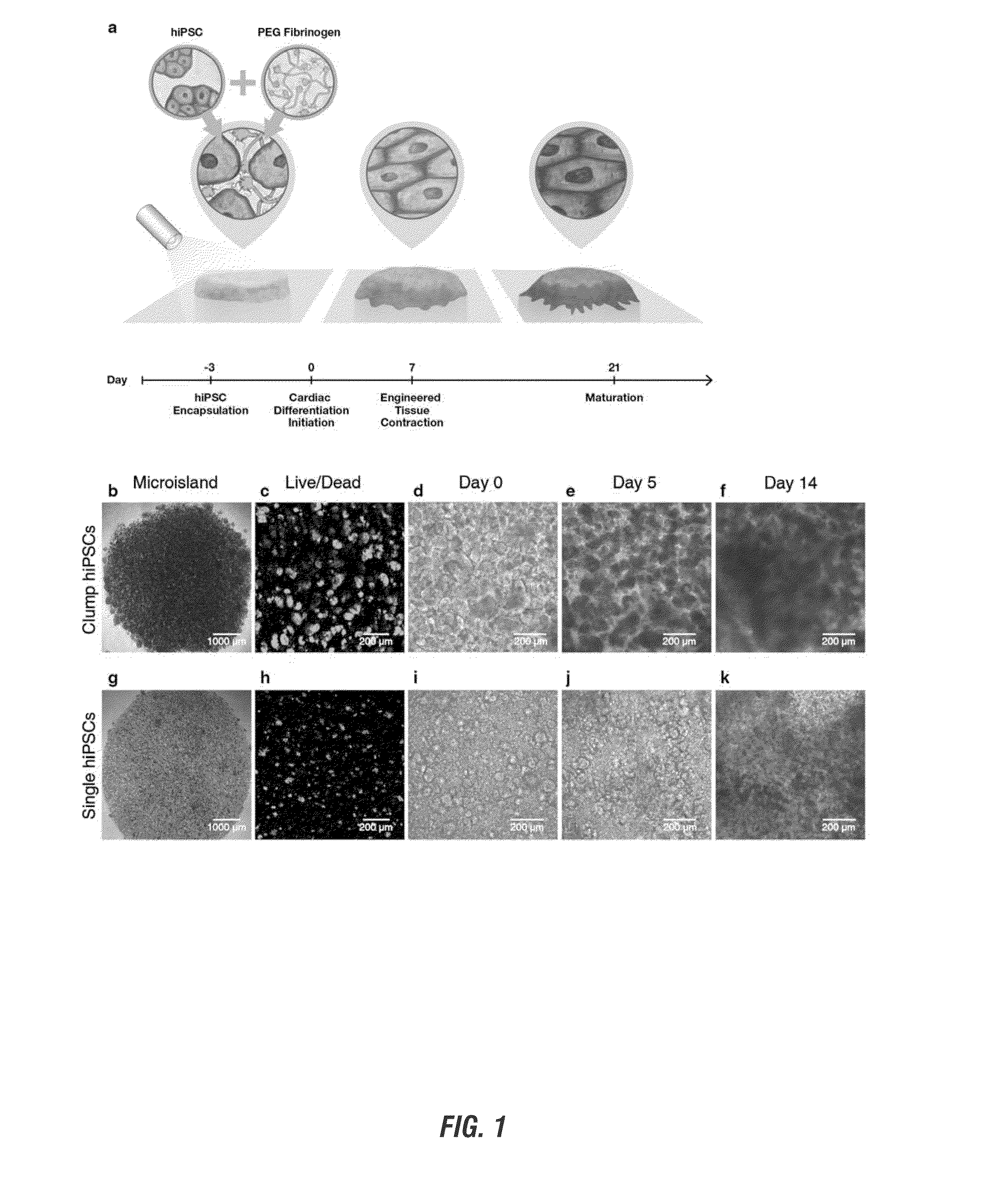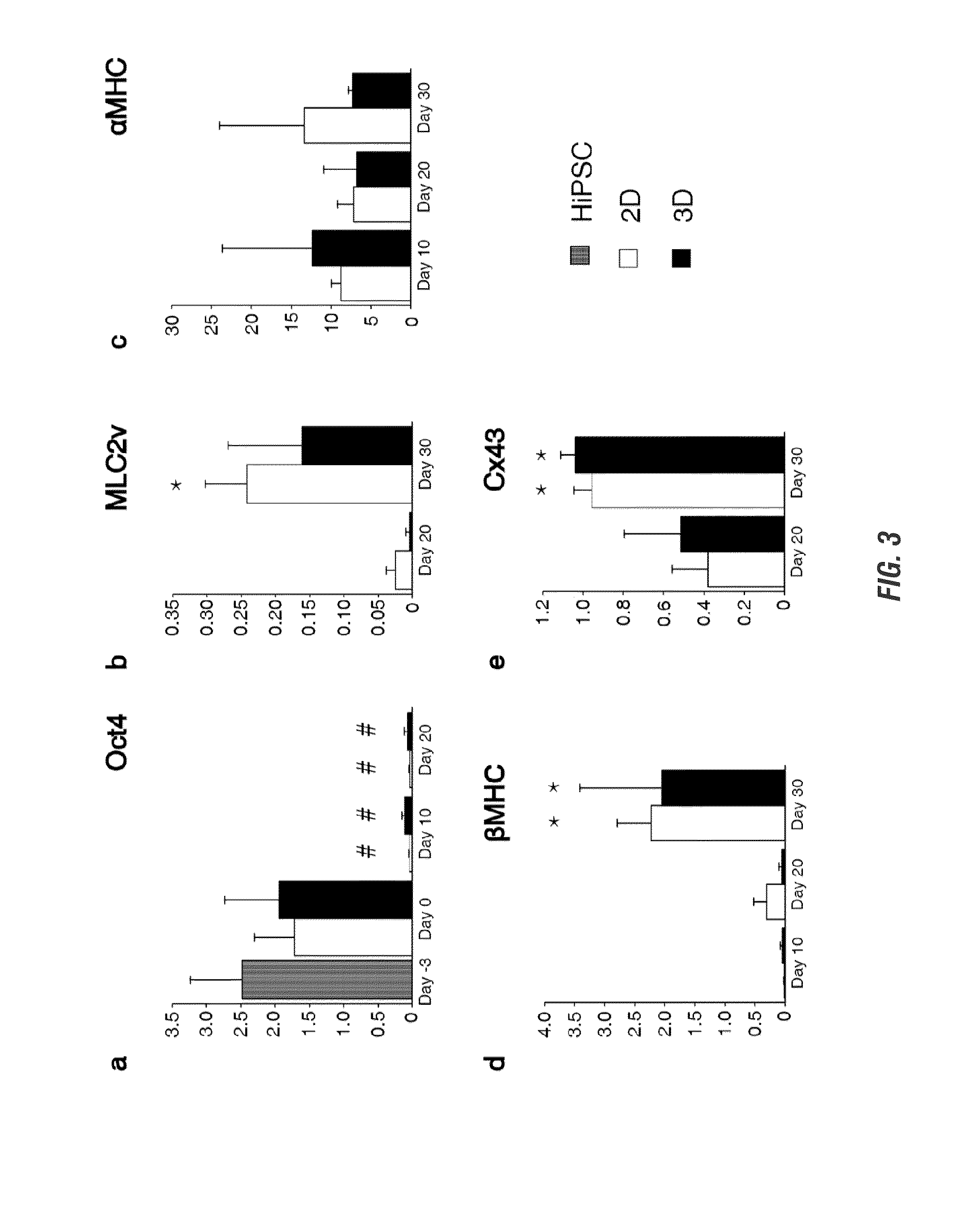ENCAPSULATION AND CARDIAC DIFFERENTIATION OF hiPSCs IN 3D PEG-FIBRINOGEN HYDROGELS
a technology of peg-fibrinogen hydrogel and encapsulation, which is applied in the field of encapsulation and cardiac differentiation of hipscs in 3d peg-fibrinogen hydrogel, can solve the problems of unclear boundaries between them, 20-30% drug withdrawal from the market, and not directly repair damaged myocardium
- Summary
- Abstract
- Description
- Claims
- Application Information
AI Technical Summary
Benefits of technology
Problems solved by technology
Method used
Image
Examples
example 1
PEG-Fibrinogen Hydrogels Support Stem Cell Survival and Proliferation
[0104]HiPSC Expansion and Culture.
[0105]IMR-90 Clone 1 human induced pluripotent stem cells (hiPSCs) were purchased from WiCell and maintained at 37° C., 5% CO2, and 85% relative humidity. HiPSCs were cultured as colonies on hESC qualified Matrigel (BD Biosciences) using mTeSR-1 media (Stem Cell Technologies). HiPSCs were passaged using Versene (Life Technologies) and 5 μM ROCK inhibitor (Y 27632, R&D Systems) was added to the mTeSR-1 media for 24 h post-seeding.
[0106]HiPSC viability on day −2 (24 hours post-encapsulation) was assessed using a LIVE / DEAD® viability kit (Molecular Probes) following manufacturer's instructions. Z-stacks (step size=5 μm) throughout the entire tissue thickness at several randomly selected locations within microislands were taken (n=3 locations per microisland). The percentage of viable cells was quantified by manual counting at two depths (33% and 75% height) per acquired stack using NI...
example 2
3D Encapsulated hiPSCs Form Synchronously Contracting, Functional Cardiac Tissues
[0123]One-step hiPSC encapsulation and cardiac differentiation process successfully resulted in synchronously contracting cardiac tissues with first areas of contraction by day 7 of differentiation for all performed hiPSC encapsulations. Microislands formed using both clump and single hiPSCs were all observed to contract (n>40 separate differentiations) with initiation of contraction occurring in localized areas between day 7 and day 11 depending on dissociation technique. Spontaneously contracting areas increased in number and synchronicity of contraction in both clump and single hiPSC encapsulated microislands over time, resulting in uniform contracting cardiac tissues by day 14.
[0124]Video recordings of spontaneously contracting cardiac tissues were acquired on a phase contrast microscope (Ti Eclipse, Nikon) using a high speed camera (Andor Luca S) to determine frequency of contraction. Number of con...
example 3
Developing Cardiac Tissues Express Cardiac Genes and Cardiac Efficiency Similar to Control 2D Monolayers
[0125]Tracking the ability to successfully and efficiently differentiate encapsulated hiPSCs into CMs, differentiation efficiency using flow cytometry and assessment of pluripotency and cardiac gene expression was shown to be similar to high efficiency 2D monolayer differentiation.
[0126]To determine the efficiency of cardiac differentiation in 3D, the expression of cTnT was evaluated by flow cytometry on day 20 microislands. On day 20, 2D sheets were washed with PBS and incubated in 0.25% trypsin (EDTA, Mediatech) at 37° C. for 5 min. Age-matched 3D tissues were washed with PBS followed by 2 h incubation at 37° C. on a rotator (Boekel Orbitron Rotator, Model 260250, Boekel Scientific) with collagenase Type 2 (1 mg / ml, Worthington) in 120 mM NaCl, 5.4 mM KCl, 5 mM MgSO4, 5 mM Na-pyruvate, 20 mM glucose, 20 mM taurine, and 10 mM HEPES (pH 6.9) supplemented with 30 μM CaCl2, followed...
PUM
 Login to View More
Login to View More Abstract
Description
Claims
Application Information
 Login to View More
Login to View More - R&D
- Intellectual Property
- Life Sciences
- Materials
- Tech Scout
- Unparalleled Data Quality
- Higher Quality Content
- 60% Fewer Hallucinations
Browse by: Latest US Patents, China's latest patents, Technical Efficacy Thesaurus, Application Domain, Technology Topic, Popular Technical Reports.
© 2025 PatSnap. All rights reserved.Legal|Privacy policy|Modern Slavery Act Transparency Statement|Sitemap|About US| Contact US: help@patsnap.com



